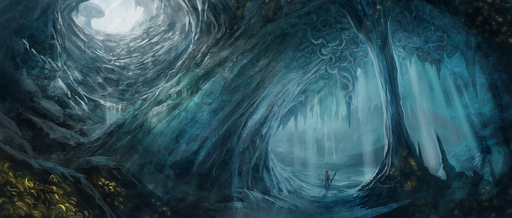Using Jigsaw Fantasy 1: Environments

The environment is nature trying to make your life interesting. Or difficult, whichever you prefer.
Unless your entire travel segment goes “it takes three weeks, and you arrive in the next city”, you are going to need something about where you are travelling through. Even in the city, the local environment has an effect – on architecture, on clothing, even on the demeanor of the inhabitants. Compare Alexandria with Venice with Oslo. The ancient versions, not the skyscraper forests. Any era before air conditioning and central heating, where you live affects you.
But the environment is particularly relevant to those who leave the city and explore the wildernesses – notably adventurers. Hacking through a forest, isn’t quite the same as punting through a swamp, sailing a boiling sea, or trekking through the desert.
When we write an environment focused Jigsaw Piece, we give you only the interesting bits. You don’t care about the assorted desert rodents whose function is largely to feed the desert fox – unless either is likely to attack you. We give you the odd parts – magical beasties to be your familiar, things that might attack you, people who might talk to you – those elements that make stories interesting. What fascinating flora are there? How do people get around? What might you find there to make travelling through that place worth your time?
We assume that if you’re running a campaign set in a fantasy Ancient Egypt, that you can go look at a whole lot of Mundane Egypt – whether by browsing an encyclopedia, or by Googling “pyramid design”. Or by catching the History channel. Or something.
Where you want our help is where the Fantasy deviates from the Mundane. Exactly how do you make a mummy animate? Why would anyone want to? If the are real gods why don’t they interfere with mortal lives? Do they? Can we stop them?
Using Jigsaw links
The footnotes section in Jigsaw Fantasy Pieces is the key to using. We’ve been running games for years, and most of us can integrate a new setting element into our games fairly easily – when a new splatbook is released, when the players walk off the currently designated map, or when someone starts a new character in a class we’ve not played with before – but even so it can take a bit of mental effort to tie things in, especially things coming from different publishers
For each element – character, critter, custom, or treasure – we’ve thought about how and why we’d run with it in different settings. So at the start of the Sivatag Desert 1)by the way, Sivatag is Hungarian for desert – it’s a quick and simple way to generate names, and as you can see on Wikipedia it is a timehonoured practice. we give you:
“The Sivatag Desert could be an area in the world of Dark Sun, or ideas from this document could be spread throughout the setting. The area would also fit into the classic or Planescape D&D cosmology as somewhere on the border between the elemental realms of Fire and Earth, or somewhere in the less inhabited parts of the lower (evil) planes. In a post-apocalyptic setting such as Fallout it may make a good replacement for the Sahara, Namib, Gobi or Arizona deserts.”
So, why might you need such a desert? Dark Sun has plenty – why introduce another?
There are dozens of reasons why you might want to have something a bit different from exactly what the system source material says – Maybe your players have played in that world before. Maybe you’ve written a cool new world part over here, but need to fill out the blank spaces on your map. Maybe you’re short on time right now, and plan to write a whole world yourself, but you want some inspiration to make the process quicker – so that your players can get stuck right in. Or maybe you just like our setting books better than Wizards of the Coast’s ones, and never actually bought Dark Sun.
Environments provide challenges for stories to face – and either overcome or not. Think about Tolkien – why do the party end up in the Mines of Moria? Because they are beaten by the environment of the Misty Mountains – the cruel slopes of Caradhras.
Whether you choose to use the challenges of the environment as set dressing, or require many tests of skill from your heroes to make it through in good shape – and to avoid combat with the native creatures – knowing what those challenges are will always add depth to your game.
Where you are is only the start of this part of your story, though. Who do you meet? What do you fight? And what treasures do you win along the way?
References
| 1. | ↑ | by the way, Sivatag is Hungarian for desert – it’s a quick and simple way to generate names, and as you can see on Wikipedia it is a timehonoured practice. |
